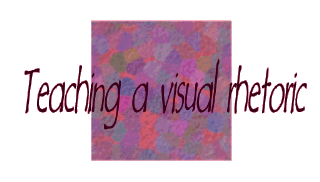In the third and final semester of my project,
I incorporated the principles of visual rhetoric from the start, making
it part of my overall composition class curriculum. This
time I created, from the beginning, a completely web-based paperless
class. All assignments given, received, and read were either posted to our webboard, a private,
controlled online environment, or were part of an overall Web site portfolio
project due at the end of the semester. What I discovered amazed me.
Rather than develop several incongruent essays on various topics, my
students began to think in terms of holistic themes. And the process
of writing took on new meaning as Web pages were designed,
altered, sometimes even redesigned, to fit into the overall context that
my students were building over the course of a semester. The essay was
seen as a process, not a product, and designs were constantly tested against
different audiences to ensure their effectiveness. Students understood that
changes in form were ongoing, that in the electronic space text is constantly
mendable, pliable, changeable. In addition, their content was geared toward
a more realistic audience than the traditional writing instructor.
My ethos faded behind the notion that there was a real audience out there
in the electronic space. They were writing for not only their peers,
but the general public as well. In short, they had a sense of power and
commitment to the task because they had a real voice, and they
understood the navigational power of the reader in the electronic space.
RESEARCHING THE SUBJECT...
What does this mean? Well, perhaps we need to consider that
the marketplace of electronic discourse communities and our own rhetorical
communities are not just separate themes running concurrently in our
increasingly technological world, but rather, they are separate ends
to the same means. Rhetoric operates much like the birch tree. It is
pliant, flexible, often changing its form. The tree will bend in compliance
to the wind’s forces just as Bitzer’s rhetorical situation will make a
“fitting response,” one firmly established by its situation (10). A birch
tree by the sea will often grow crooked, bending its limbs sideways to flow
within the force of a constant ocean breeze. It houses living things, seaside
birds, insects, and small rodents burrow in the ground near its shade-bearing
trunk. The birch tree does not exist separately from the wind, but lives within
its environment, establishes itself as a functional member of its ecosystem.
This is how we rhetors need to view our roles within our current rhetorical
situation. In short, we are the tree and technology is the wind that constantly
blows us into shape. How we mold ourselves depends completely on our ever-changing
electronic environment, its prevalence in our society, the trends it sets
in conjunction with our consumer society.
Perhaps current traditionalists should look at the positive
implications of a Web site project which incorporates visual rhetoric.
Lanham tells us “in electronic media, readers, writers, producers, and
users experience the text as something “bi-stable,” something that oscillates
from the transparent to the opaque, from the unself-conscious to the
self-conscious, from that which is looked through to that which is
looked at” (80-83). In visualized English studies, Stroupe tells us,
“writers are ... conscious of the need to resist the traditional impulse
to isolate themselves in the cozy kitchen of verbal literacy. [...]
Words don’t simply talk to words, but to images, links, horizontal lines—to
every feature of the iconographic page” (618). This is the new literacy
that surrounds our culture—a literacy that will eventually effect the
way composition is taught, making the Harvard School of Thought an antiquated
means of writing, because in our society effective writing has and continues
to be synonymous with communication.
Visual rhetoric is only one aspect of
electronic writing that sets it apart from the traditional print text.
“Hypertext seems to suggest... a different way of thinking about writing
than does the traditional essay form,” Thomas Reynolds explains. “Theorists
of hypertext such as George Landow and Jay David Bolter tend to emphasize
the associational character of (hypertextual) writing. ‘Connectivity’
of texts and ideas takes precedence over the linear assumptions of print
forms” (142). Simply put, the author of a Web site understands that he
or she has no control over the depth, breadth, or route a reader will take
when viewing his or her site. The control is not in the writer’s words,
but with the reader’s choices. This altered attitude about the roles we must
play in order to communicate, the considerations we must have about the
written and visual word, and the importance of disseminating information
in a reader friendly manner makes us better writers.
|
